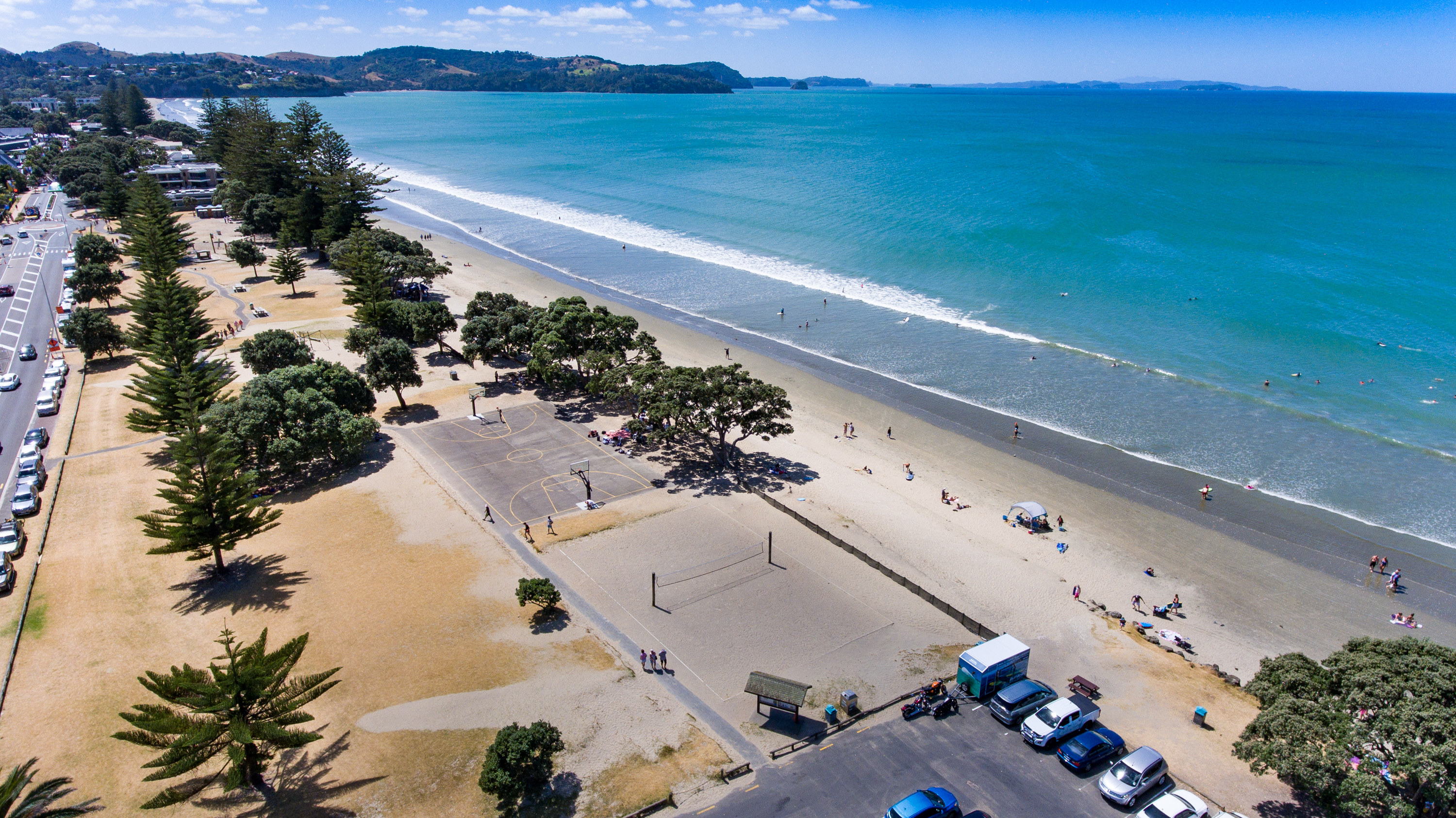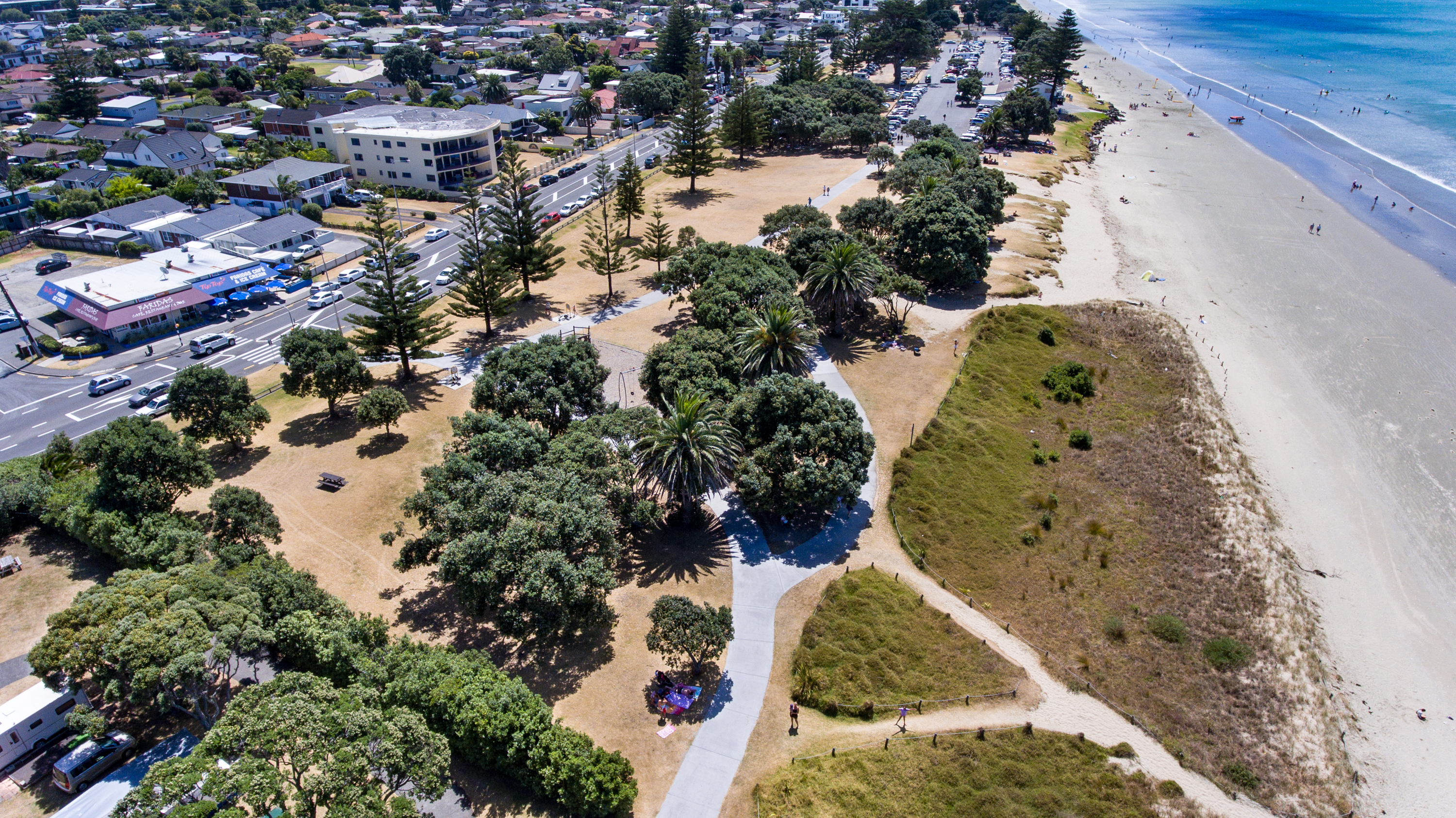Te kaupapa mahi o Te Whakahaere i te Anamata o Te Rāhui ki Ōrewa
Ōrewa Reserve Future Management project

Drone shot of a section of Ōrewa Reserve.
Managing erosion in Ōrewa
Ōrewa Reserve's coastline is facing serious erosion issues due to rising sea levels and climate change.
As part of the Ōrewa seawall project, we are building a seawall and shared path at the northern end of the beach between Marine View and Kohu Street. The narrow section of esplanade reserve is vulnerable to erosion. Without the seawall, there will be no walking access during high-tide.
Getting approval for the seawall project was a challenging and costly process for the council. The proposal went to the Environment Court for the final decision.
This is why we are considering other ways to manage erosion along Ōrewa Beach.
Restoring the dunes
As sea levels rise, beach areas in front of seawalls will become increasingly submerged during higher tides.
Restoring the dunes at the reserve will help maintain an area of dry sand on the beach even when the tide is high. This will provide a larger area of beach for the public to enjoy.
Project overview
The Ōrewa Reserve Future Management project aims to manage erosion by restoring the dunes at the reserve. This project aligns with the Shoreline Adaptation Programme that looks at how we manage the effects of climate change on Auckland’s coastlines.
We want to create a gentle slope through the dunes to the beach. This will be better than the sharp drop off between the reserve and the beach that often happens due to erosion.
In time, the restored dunes will look like the dunes at the southern end of the beach in front of the Ōrewa Beach Holiday Park.
Ōrewa Reserve is an ideal location for dune restoration because there is enough space to:
- allow the high tide to find its natural position
- restore dunes in the correct location
- plant native grasses on the dunes.

Drone shot of established dunes at southern end of Ōrewa Reserve.
Benefits of dune restoration
Restoring the dunes will:
- improve access through the dunes to the beach
- create an extended ‘dry sand’ beach for recreation through the full range of the tides
- accommodate rising sea levels and adapt naturally to coastal changes
- protect reserve facilities from coastal hazards
- reduce the need for regular and costly sand transfers at the reserve
- improve the dune environment by planting suitable grasses and shrubs
- eliminate the need for expensive seawall repairs and maintenance
- reduce wind-blown sand.
The dune landscape will experience some damage following storm events, but they will recover naturally. From time to time, they could require some reshaping and replanting.
Additional project considerations
Norfolk pines and pōhutukawa trees
The Norfolk pines and pōhutukawa trees growing along the eroded edge of the reserve are vulnerable to coastal storms. About 20 years ago, Rodney District Council planted more trees away from the coastal edge. These trees are now beginning to mature and enhance the reserve.
Facilities on the reserve
Over time, we will need to relocate some council facilities away from the coastal hazard zone:
- playgrounds
- ball courts
- barbecue areas
- southern toilet block
- car parks.
The Ōrewa Surf Life Saving Club's new building will be built further away from the beach.
Ngāti Manuhiri support
Ngāti Manuhiri are one of the iwi for Ōrewa and hold mana whenua (customary authority) over the reserve. They support dune restoration at Ōrewa Reserve as it aligns with their values of protection and improvement of:
- natural environment
- wai (water)
- moana (ocean)
- wāhi tapu (sacred space).
Public feedback on the concept options
We have developed four concept options as a result of:
- the study of visitor’s experiences at Ōrewa Reserve
- council’s commitment to exploring dune restoration as a management option.
You can give feedback on the concept options on akhaveyoursay.nz when consultation opens in April 2025.
Download the concept design options to find out more.
How visitors use Ōrewa Reserve
We looked at how visitors experience the reserve through:
- drone footage
- visitor surveys
- observation
- mapping preferred routes across the reserve.
The results of the study show:
- the beach is more popular than the grassed area of the reserve
- playgrounds are the most popular facility followed by the basketball court
- walking and cycling along the length of the beach are an important exercise option.
Project timeline
October 2024 to April 2025
Engage with key stakeholders on the concept designs.
April to May 2025
Consultation opens for public feedback on the concept options.
May 2025
Compile public feedback and establish the preferred concept option.
June to July 2025
Share the preferred concept option with Hibiscus and Bays Local Board for its feedback.
More information
Download the Ōrewa Recreation Reserve Future Management report and local board meeting minutes to find out more.
Related topics
Is the information on this page helpful?
It is helpful for us to know what works well for customers.
You will not receive a reply. Do not include personal information.
